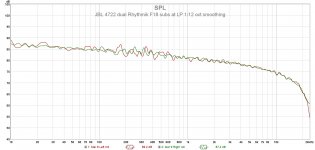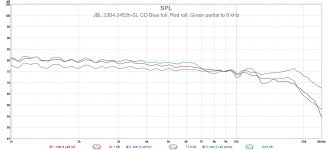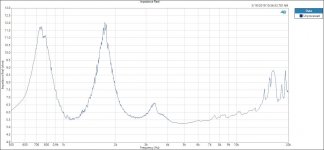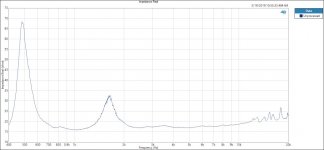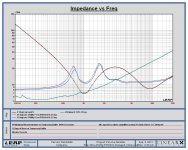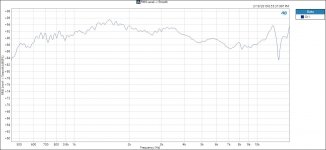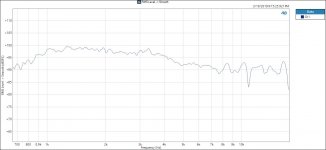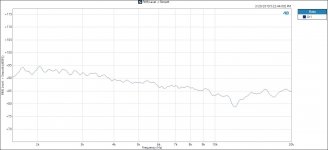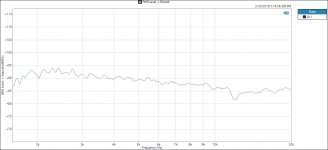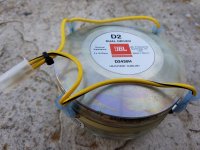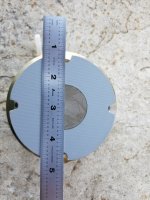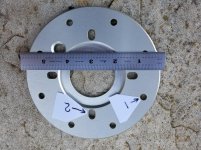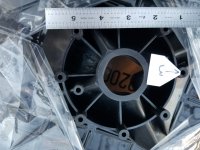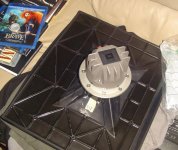nice.
the newest pth1010hf-1 waveguide, in both jbl speakers that use it (am5212/00 and am7212/00), both use a 3khz notch in the passive crossover. The 5212 has a notch at 10khz also, close to a peak in its 2408h response. I wonder if the 3khz notch is for a horn resonance from the square-ish mouth or as frequency shaping for the falling compression driver response in the non narrowing thusly non high frequency boosting horn.
Either way, it looks like a winner.
the newest pth1010hf-1 waveguide, in both jbl speakers that use it (am5212/00 and am7212/00), both use a 3khz notch in the passive crossover. The 5212 has a notch at 10khz also, close to a peak in its 2408h response. I wonder if the 3khz notch is for a horn resonance from the square-ish mouth or as frequency shaping for the falling compression driver response in the non narrowing thusly non high frequency boosting horn.
Either way, it looks like a winner.
Last edited:
Hello Norman,
I have been using that PT H1010HF-1 waveguide for a few weeks in my small listening room. I have tried out the JBL 2451J-SL auquaplased Ti and the JBL2432H compression drivers. To set these up I used a 1/3 octave Real Time Analyzer and graphic equalizer. I did not find any huge peaks that needed a notch filter to correct. There is the roll off typical a CD mass break roll off. The equalizer is used to boost the frequencies as the CD's naturally roll off. I like these JBL 100 X 100 waveguides.
I am looking forward to taking better resolution measurements with a AP audio analyzer and microphone when it quits raining.
Thanks DT
I have been using that PT H1010HF-1 waveguide for a few weeks in my small listening room. I have tried out the JBL 2451J-SL auquaplased Ti and the JBL2432H compression drivers. To set these up I used a 1/3 octave Real Time Analyzer and graphic equalizer. I did not find any huge peaks that needed a notch filter to correct. There is the roll off typical a CD mass break roll off. The equalizer is used to boost the frequencies as the CD's naturally roll off. I like these JBL 100 X 100 waveguides.
I am looking forward to taking better resolution measurements with a AP audio analyzer and microphone when it quits raining.
Thanks DT
Red horn ?
Nice.
The qsc waveguide looks real good also.
Hard to say, the 2384 is very special, but it is deep. Nice rounded edges, sort of rounded conical, good mouth to baffle round over, and no hard corners. But it is a 600hz horn.
The jbl 2435hpl compression driver is very special driver, worth 1.1k in my book (new).
...
Norman
Hi Norman, I do like the 2384 waveguide, but it has one or two wrinkles, at least for me. Pushing the limits of the top octave and the throat to the CD could be smoother. The "screen array" design of this waveguide has increased directivity in the top octave, as it was designed to be behind cinema screens.
I had a look at a few measurements of that 2435hpl CD, very nice! Would love to hear it.
Hello,
This stuff is interesting.
You look at the measurement graphs of all of these waveguides and compression drivers they all have ripples. It looks that the cone and dome drivers have similar frequency response issues.
Thinking about it, a 1/3 octave band graphic equalizer can do a lot to help to smooth out the frequency peaks and dips. Then again the frequency response peaks and dips may not line up with the 1/3 octave band frequencies of the equalizer. I may be trying to slice the peach in too thin of slices, I don’t know.
Seem like a couple of moderate peaks and dips between 10KHz and 20KHz, you know the top octave, may not be all that audible anyway.
I like the way these 100 X 100 ish waveguides sound in my small playback space. The 90 X 50 ish and tighter waveguides seem to be too focused for my taste.
I did order a pair of the M2 waveguides to checkout with different drivers in my playback space.
Thanks DT
Hello DT, thanks. Yes, I use a software DSP package to smooth out the frequency response. It also provides linear phase digital XO, time alignment and excess phase correction capabilities.
Full range response of my system ~10ft at the LP:
I can make adjustments to the target fr response or other parameters (including timing), generate the FIR correction filter and be A/B'ing music in near real time in a couple of minutes.
Below, Red trace is the same as the response above, but zoomed in a bit from 1 kHz. The target design follows the natural fr rolloff of the 2453h-SL CD. The Green trace is the same target as Red, but partial correction to 8 kHz and then let the horn and CD do its thing. The Blue trace is a straight line target correction from 20 Hz to -10 dB at 20 kHz:
Same 1/12 oct smoothing. Listening to music while switching back and forth from the three responses with a 3/4 second switching delay (linear phase FIR filter with 65,536 taps). The correction following the natural roll off of the CD sounds best (Red).
DT, I am looking forward to hearing your adventures with the M2 waveguide as that to me seems to be better waveguide than the 2384. I would welcome a wider pattern. But I don't know how low it will go...? Are you going to use a 4" or 3" diaphragm?
Cheers,
Mitch
Attachments
Hello,
The optimized target frequency is still a mystery. I have been using a 1dB per octave slope (a negative straight line slope).
Mitch, I have read your book. When it was delivered a couple or three month ago I think that the ink was still wet. You have my eyes open seeing all the DSP stuff you are doing, cool. At this point I am a bit shy about a second computer for the DSP stuff. The computer for the test bench is the head and face of my audio analyzer. Plus much of what I listen to is vinyl, to be a little old school I prefer to keep the digital out of the vinyl playback. This could change down the road.
With the M2 waveguides I will be trying out the JBL 2451J SL (4in), JBL 2432H (3in) and D2 (special case) CD’s. There may be a need to fabricate a couple different adapter flanges with different bolt circles.
Sorting out the test instruments and software is fun too.
Thanks DT
The optimized target frequency is still a mystery. I have been using a 1dB per octave slope (a negative straight line slope).
Mitch, I have read your book. When it was delivered a couple or three month ago I think that the ink was still wet. You have my eyes open seeing all the DSP stuff you are doing, cool. At this point I am a bit shy about a second computer for the DSP stuff. The computer for the test bench is the head and face of my audio analyzer. Plus much of what I listen to is vinyl, to be a little old school I prefer to keep the digital out of the vinyl playback. This could change down the road.
With the M2 waveguides I will be trying out the JBL 2451J SL (4in), JBL 2432H (3in) and D2 (special case) CD’s. There may be a need to fabricate a couple different adapter flanges with different bolt circles.
Sorting out the test instruments and software is fun too.
Thanks DT
Hi DT,
Thanks for purchasing my book. Here is some info I compiled from Sean Olive on The Science of Preferred Frequency Responses for Headphones and Loudspeakers with links to studies and AES papers. The negative straight line slope is a good target. I round mine off the top due to increased directivity in the top octave (screen spreading compensation of the 2384 waveguide).
Understood on the vinyl and 2nd computer. Note both Acourate and Audiolense has RIAA digital correction capabilities if you decide to go that route...
Thanks for letting me know the CD's you will be trying out. Awesome! It be very interesting to see your results. I believe member sebackman on the Lansing Heritage site has a spec for an adapter for the 2451 to M2: Compact monitor - Page 6
REW is excellent freeware commonly used for acoustic measurements, as it has several different chart displays. Plus has overlay capability for comparisons with not only one's own measurements but can be shared with members as well.
Good luck!
Thanks for purchasing my book. Here is some info I compiled from Sean Olive on The Science of Preferred Frequency Responses for Headphones and Loudspeakers with links to studies and AES papers. The negative straight line slope is a good target. I round mine off the top due to increased directivity in the top octave (screen spreading compensation of the 2384 waveguide).
Understood on the vinyl and 2nd computer. Note both Acourate and Audiolense has RIAA digital correction capabilities if you decide to go that route...
Thanks for letting me know the CD's you will be trying out. Awesome! It be very interesting to see your results. I believe member sebackman on the Lansing Heritage site has a spec for an adapter for the 2451 to M2: Compact monitor - Page 6
REW is excellent freeware commonly used for acoustic measurements, as it has several different chart displays. Plus has overlay capability for comparisons with not only one's own measurements but can be shared with members as well.
Good luck!
Hello All,
We went into Sparky’s Lab (Sparky is the cat) this morning.
We connected a JBL 2432H to the PT 1010HF-1 and then a JBL 2451J to the same waveguide. Later we will do frequency response. First off we did impedance plots.
The large peaks at 1.75KHz ish surprised me. This happened with both CD’s on the same waveguide. Looks like wave guide loading to me. This 100 X 100 waveguide is looking less magical to me. Seems to me that you can tell a lot about how a horn / waveguide loads by looking at the impedance plot.
Frequency Response plots to follow.
Thanks DT
We went into Sparky’s Lab (Sparky is the cat) this morning.
We connected a JBL 2432H to the PT 1010HF-1 and then a JBL 2451J to the same waveguide. Later we will do frequency response. First off we did impedance plots.
The large peaks at 1.75KHz ish surprised me. This happened with both CD’s on the same waveguide. Looks like wave guide loading to me. This 100 X 100 waveguide is looking less magical to me. Seems to me that you can tell a lot about how a horn / waveguide loads by looking at the impedance plot.
Frequency Response plots to follow.
Thanks DT
Attachments
Actually, i think it looks real good.
Check out the jbl 2380a Z plot, it has a few impedence bumps past 1khz.
I bet in many straight path (straight then small corner, then straight again) cd horns (ev hr90, hp640), every break in horn path would cause a Z spike.
I bet the older pth has a blip near 10khz.
Magical ?
Minimal reflections make for a more accurate (hear into the details) sound.
I bet it is a very very good horn.
I expect the horn + freq response plot to be similar to plane wave response.
Without narrowing the response as you go past 3khz, you won't get free hf boost, that is actually lost off axis just to get more on axis.
Thanks for all your work on this.
Norman
Check out the jbl 2380a Z plot, it has a few impedence bumps past 1khz.
I bet in many straight path (straight then small corner, then straight again) cd horns (ev hr90, hp640), every break in horn path would cause a Z spike.
I bet the older pth has a blip near 10khz.
Magical ?
Minimal reflections make for a more accurate (hear into the details) sound.
I bet it is a very very good horn.
I expect the horn + freq response plot to be similar to plane wave response.
Without narrowing the response as you go past 3khz, you won't get free hf boost, that is actually lost off axis just to get more on axis.
Thanks for all your work on this.
Norman
Last edited:
Seems to me that you can tell a lot about how a horn / waveguide loads by looking at the impedance plot.
Wait until you do the FR measurements. I have the older version of the waveguide and it loads the bottom end quite well especially with a 4" driver. I am really curious how the 2 compare. Looking forward to seeing what you get
Rob
me too.
Remember though, the 2432 has a snout inside, folks at lansing heritage mentioned that it would do better on a longer (deeper) horn. A small or no snout inside compression driver may mate up better in the shallow waveguides of the pth horns.
"The 2431H is a very short driver from diaphragm to 1.5" exit- it has no "extension" like the 2432H. Doug Button (XDCR Engr at JBL) commented that, due to the very short throat of the 2431 and 2435, they are finicky about which horns it works well with. I don't know if the longer throat of the 2432H mounted to horns designed for the 2431H (such as the one on the SRX715's in question in this thread) is an issue or not. I somehow doubt it will matter, except for at the extreme edges of the designed coverage area of this horn. Any comments regarding this is welcomed."
"The more important concern of interest to me is if the 2431/35 or the 2432H have problems on certain horns, and if so, which ones? The comments made by JBL transducer Engineer Doug Button regarding the short throats on 2431/35 drivers and some horns keeps echoing in my head... but he didn't elaborate on which horns in that discussion."
Remember though, the 2432 has a snout inside, folks at lansing heritage mentioned that it would do better on a longer (deeper) horn. A small or no snout inside compression driver may mate up better in the shallow waveguides of the pth horns.
"The 2431H is a very short driver from diaphragm to 1.5" exit- it has no "extension" like the 2432H. Doug Button (XDCR Engr at JBL) commented that, due to the very short throat of the 2431 and 2435, they are finicky about which horns it works well with. I don't know if the longer throat of the 2432H mounted to horns designed for the 2431H (such as the one on the SRX715's in question in this thread) is an issue or not. I somehow doubt it will matter, except for at the extreme edges of the designed coverage area of this horn. Any comments regarding this is welcomed."
"The more important concern of interest to me is if the 2431/35 or the 2432H have problems on certain horns, and if so, which ones? The comments made by JBL transducer Engineer Doug Button regarding the short throats on 2431/35 drivers and some horns keeps echoing in my head... but he didn't elaborate on which horns in that discussion."
I bet the older pth has a blip near 10khz.
That's not the waveguide it's the compression drivers they are both in break-up modes above 10K. Here is a 476 on the older waveguide and it's clean up there.
The more important concern of interest to me is if the 2431/35 or the 2432H have problems on certain horns, and if so, which ones? The comments made by JBL transducer Engineer Doug Button regarding the short throats on 2431/35 drivers and some horns keeps echoing in my head... but he didn't elaborate on which horns in that discussion."
It's the short phase plug that makes them hit or miss. You would get a notch in the response. The 2435 works well on the older PTH1010. We wrestled with this a lot on LH and it really was hit or miss I don't think we ever really built a list of "good' horns/waveguides.
Rob
Attachments
Last edited:
ah, thanks rob.
Thought I saw a blip on the 2431 having zing near 15khz.
2431h
Overall, I do enjoy the horn, especially on drums and cymbals.
Definitely cleaner than 2384, just won't go as low, but one crossed at 1,200hz and the bigger near 750hz, so there is that.
Shame older pt is near $150 while newer one is around $65.
It would be neat to drop the newer one in place of my 6212.
If I drill a couple of holes, I wonder if it would................
Thought I saw a blip on the 2431 having zing near 15khz.
2431h
Overall, I do enjoy the horn, especially on drums and cymbals.
Definitely cleaner than 2384, just won't go as low, but one crossed at 1,200hz and the bigger near 750hz, so there is that.
Shame older pt is near $150 while newer one is around $65.
It would be neat to drop the newer one in place of my 6212.
If I drill a couple of holes, I wonder if it would................
Last edited:
Hello,
I still have some bugs to work out but I am operational.
I did not go outside or into a large room, not a standard distance between mic and driver so not calibrated.
With 1/24 octave smoothing here are the RMS frequency plots for the PTH1010 HF-1 with the JBL2451J and JBL 2432H Compression Drivers.
Thanks DT
I still have some bugs to work out but I am operational.
I did not go outside or into a large room, not a standard distance between mic and driver so not calibrated.
With 1/24 octave smoothing here are the RMS frequency plots for the PTH1010 HF-1 with the JBL2451J and JBL 2432H Compression Drivers.
Thanks DT
Attachments
Nice nice.
Looks about what i expected.
1st is 2432h ?
Ideally both at same db per division (block).
Hello,
2nd is 2432.
Oops I missed, I was aiming at 5dB per step. Better next effort I hope.
Thanks DT
Hello,
A couple more plots before Sparky and I leave Sparky’s Lab for a couple of weeks.
Still using the microphone for frequency response plots, not using JBL parts. This time it is a FatialPro HF 111 CD and a FatialPro Short throw 1 inch horn and a Eighteen sound 80 X 60 elliptical horn. The plots are first the FatialPro short horn and second the Eighteen sound horn.
This FatialPro HF 111 CD is the smoothest fregquncy response tested so far. Both plots are with 1/24 octave smoothing.
Thanks DT
A couple more plots before Sparky and I leave Sparky’s Lab for a couple of weeks.
Still using the microphone for frequency response plots, not using JBL parts. This time it is a FatialPro HF 111 CD and a FatialPro Short throw 1 inch horn and a Eighteen sound 80 X 60 elliptical horn. The plots are first the FatialPro short horn and second the Eighteen sound horn.
This FatialPro HF 111 CD is the smoothest fregquncy response tested so far. Both plots are with 1/24 octave smoothing.
Thanks DT
Attachments
Hello All,
More 100 X 100 waveguide and driver stuff today. Today I received the D2 drivers and M2 waveguides.
I have a couple of questions if you all can help. These D2 drivers do not attach to the M2 waveguides in the traditional way. There is an adaptor flange that is installed between the waveguide and the driver.
See the attached photos:
The driver attaches to the flange with 4 each ¼ - 20 threaded bolts. See the slotted holes tagged #2 in photos.
The flange then attaches to the waveguide with 8 “screws” that install through holes tagged with #1 and fasten into the plastic holes in the waveguide tagged # 3 in the photos.
Anyone been there done this with the 8 screws before. Plastic thread forming screws? What size? Anyone have a part number? I do not want to destroy this thing?
Thanks DT
More 100 X 100 waveguide and driver stuff today. Today I received the D2 drivers and M2 waveguides.
I have a couple of questions if you all can help. These D2 drivers do not attach to the M2 waveguides in the traditional way. There is an adaptor flange that is installed between the waveguide and the driver.
See the attached photos:
The driver attaches to the flange with 4 each ¼ - 20 threaded bolts. See the slotted holes tagged #2 in photos.
The flange then attaches to the waveguide with 8 “screws” that install through holes tagged with #1 and fasten into the plastic holes in the waveguide tagged # 3 in the photos.
Anyone been there done this with the 8 screws before. Plastic thread forming screws? What size? Anyone have a part number? I do not want to destroy this thing?
Thanks DT
Attachments
Hello DT
I had the holes tapped and put in helicoils. You can do it yourself if you are comfortable doing it. It worked out well as you could repeatably remove the plate and not worry about loosing a mounting hole due to wear. I think they are 10/32 easy to see which one with screws in hand.
Rob
I had the holes tapped and put in helicoils. You can do it yourself if you are comfortable doing it. It worked out well as you could repeatably remove the plate and not worry about loosing a mounting hole due to wear. I think they are 10/32 easy to see which one with screws in hand.
Rob
Attachments
Last edited:
- Home
- Loudspeakers
- Multi-Way
- JBL PT 100x100 waveguides, any experience? MPro?
